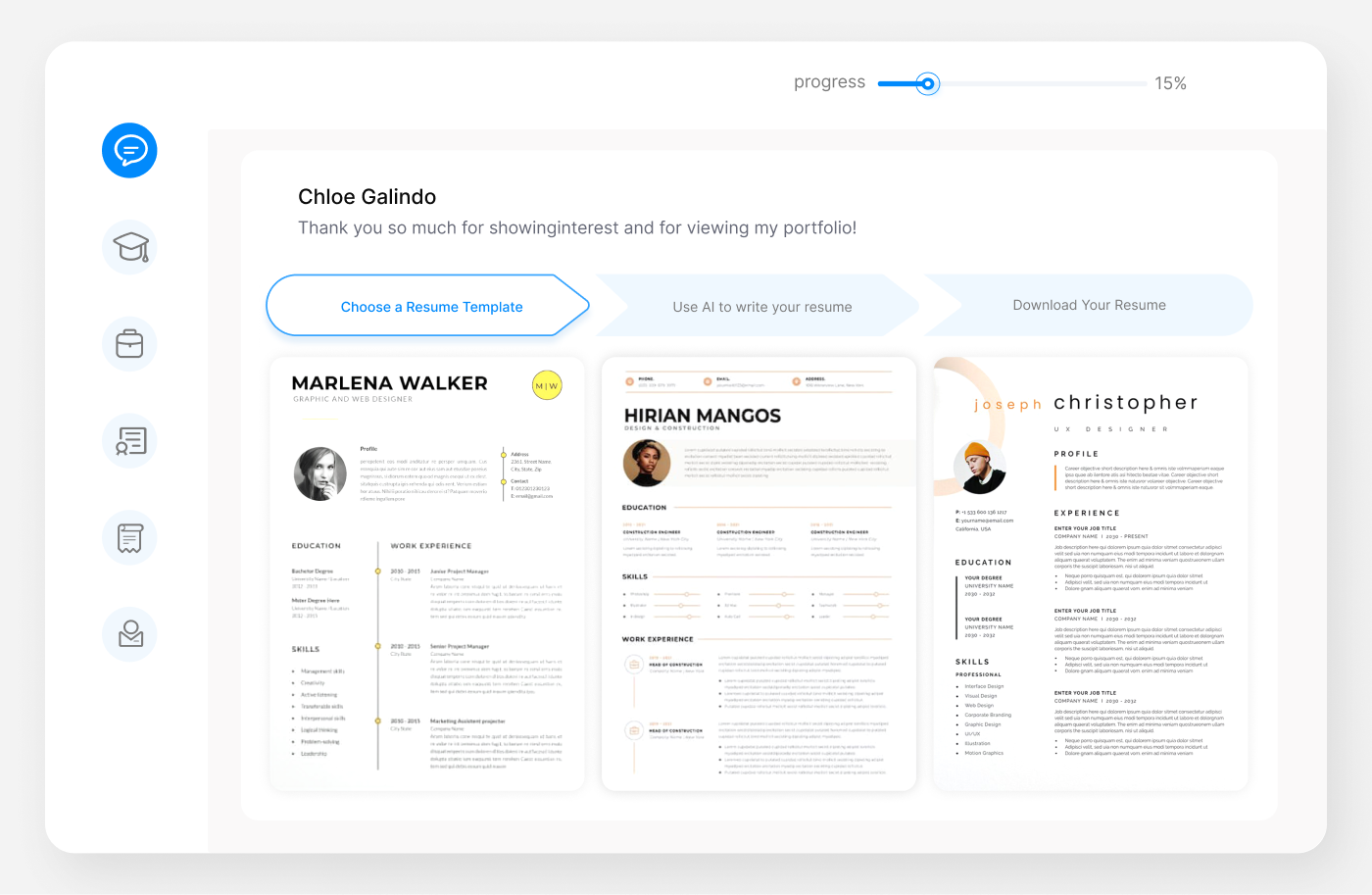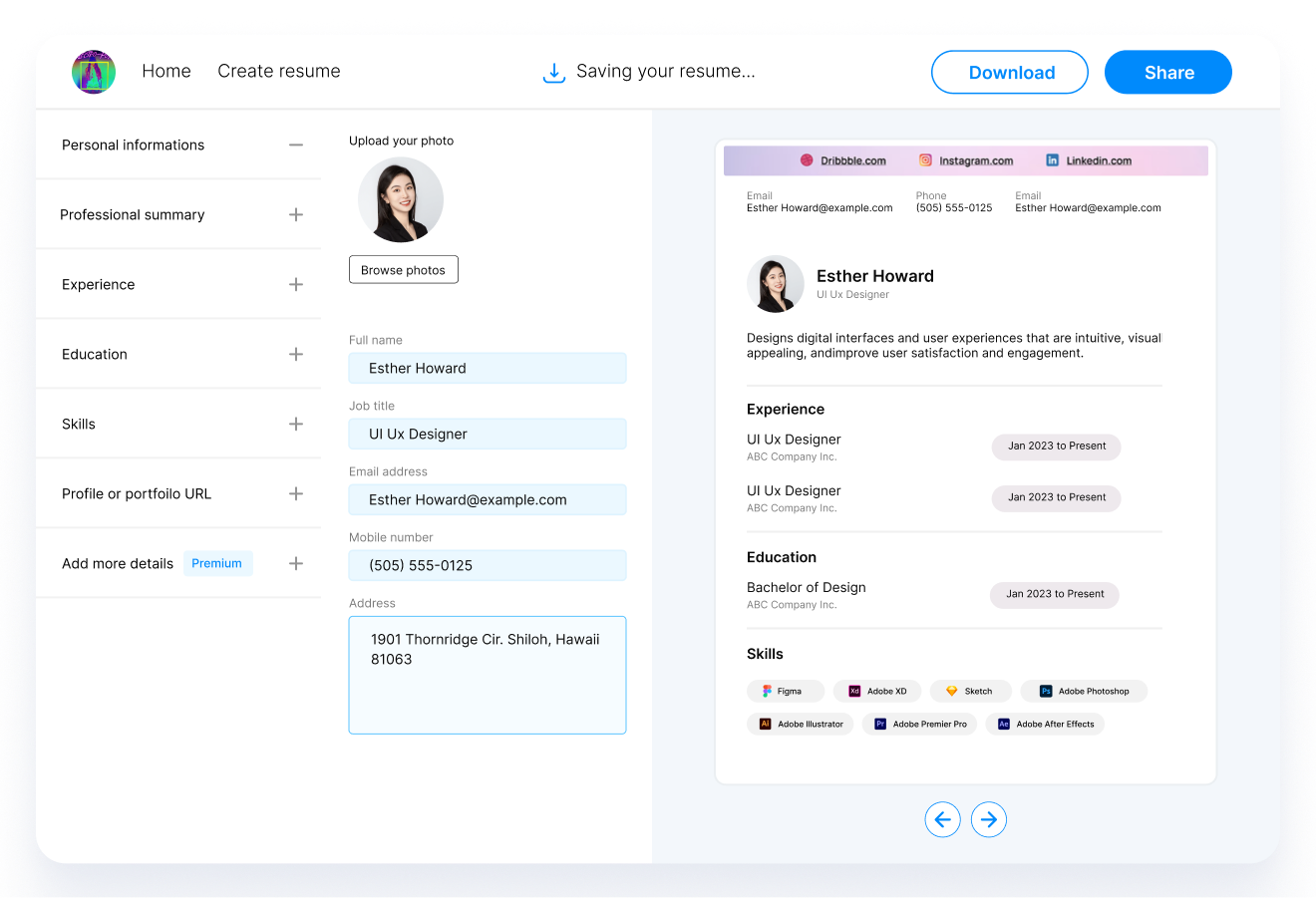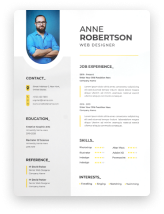In the ever-evolving world of Information Technology, the role of a Data Scientist stands out as both challenging and rewarding. Crafting a resume for such a dynamic position requires more than just listing your technical skills and educational background. It's about narrating your journey as a data explorer and problem-solver. This guide dives deep into the specifics of what makes a Data Scientist's resume not just good, but great. We'll take you through industry-focused writing techniques, layout strategies, and practical examples to ensure your resume is a standout reflection of your professional prowess.

Data Scientist Resume Example
Crafting a Standout Data Scientist Resume
Martin Greene Data Scientist
Email: martin.greene@example.com
Phone: (123) 456-7890
LinkedIn: linkedin.com/in/martingreene
Professional Summary:
Innovative and results-driven Data Scientist with over 5 years of experience in leveraging data-driven insights to drive business improvements, operational efficiency, and predictive analytics. Proven track record in designing and implementing machine learning models and advanced statistical methods to solve complex business problems.
Professional Experience:
Senior Data Scientist
X Tech Solutions
New York, NY June
2018 - Present
-
Lead a team of data analysts to optimize data-driven strategies for client-focused solutions.
-
Developed an award-winning predictive model that increased customer retention by 20%.
-
Collaborated with cross-functional teams to implement a real-time analytics dashboard, enhancing decision-making processes.
Data Scientist
Innovative Analytics
San Francisco, CA
July 2015 - May 2018
-
Automated data processing workflows, resulting in a 30% reduction in processing time.
-
Conducted extensive data mining and analysis to inform strategic planning for diverse clientele.
-
Presented findings to stakeholders, influencing key decisions on product development and marketing strategies.
Education:
Master's Degree in Data Science
University of Minnesota
Twin Cities | 2015
Bachelor's Degree in Computer Science
University of Wisconsin
Madison | 2013
Skills:
-
Programming Languages: Python, R, SQL
-
Machine Learning, Predictive Modeling, Data Mining
-
Data Visualization (Tableau, PowerBI)
-
Big Data Platforms (Hadoop, Spark)
-
Statistical Analysis, A/B Testing
Certifications:
-
Certified Data Scientist - Data Science Council of America
-
Machine Learning Specialist - Coursera
Professional Associations:
-
Member, Data Science Association
-
Member, International Association of Computer Science and Information Technology
Resume Format or Structure
Unveiling the Blueprint: Structuring a Data Scientist Resume
Crafting a resume as a Data Scientist in the IT industry is akin to designing a complex data model. It's about presenting information in a clear, concise, and logical format that makes it easy for potential employers to understand your professional story. Here's how you can structure your resume to make an impact:
-
Header: Contact Information Begin with your name, professional title (Data Scientist), and contact information, including your phone number, email, and LinkedIn profile. This should be easily visible at the top of your resume.
-
Professional Summary This is a brief, impactful statement summarizing your professional background, key skills, and what you bring to the table. Tailor this section to the job you're applying for, highlighting relevant accomplishments.
-
Professional Experience List your work experience in reverse chronological order. For each role, include your job title, the company name, the dates of employment, and a bulleted list of your key responsibilities and achievements. Use quantifiable data to demonstrate the impact of your work.
-
Education Detail your educational background, starting with the most recent degree. Include the name of the institution, the degree obtained, and the year of graduation. If you have a higher degree relevant to data science, prioritize it over your undergraduate degree.
-
Skills Highlight specific skills relevant to a Data Scientist role, such as programming languages (Python, R, SQL), machine learning, data visualization tools (Tableau, PowerBI), and big data platforms (Hadoop, Spark).
-
Certifications and Professional Associations Include any certifications that add value to your role as a Data Scientist and membership in professional organizations. These demonstrate your commitment to continuous learning and staying updated with industry trends.
-
Additional Sections Depending on your experience and the job requirements, you can add additional sections like Projects, Publications, or Volunteer Experience. These provide a more holistic view of your capabilities and interests.
Resume Summary or Objective
Decoding Success: Writing a Persuasive Data Scientist Resume Summary
The summary or objective on a Data Scientist's resume is more than just an introduction. It's your elevator pitch, a concise amalgamation of your skills, experience, and career aspirations. Here's how to craft a compelling summary:
-
Tailor to the Job: Customize your summary to reflect the key qualifications and requirements of the Data Scientist role you're applying for. Use relevant keywords from the job description.
-
Highlight Achievements: Focus on your major achievements, particularly those where you've used data to drive decisions or solve problems. Quantifiable results, like "developed a model that improved efficiency by 30%," make your accomplishments more tangible.
-
Showcase Your Skills: Briefly mention your core skills. For a Data Scientist, this could include expertise in programming languages, statistical analysis, machine learning, and data visualization.
-
Express Career Goals: If you're writing a career objective, articulate your professional goals and how they align with the position and the company's objectives.
Example Resume Summaries:
Example 1:
Dynamic Data Scientist with over 7 years of experience in extracting insights from large datasets to drive business growth. Expert in predictive modeling, machine learning, and data visualization. Proven track record in developing innovative analytical solutions that increased revenue by 25% for a leading e-commerce platform.
Example 2:
Aspiring Data Scientist with a strong foundation in statistical analysis and Python programming. Recently graduated with honors from XYZ University, eager to apply academic learning in a practical environment. Passionate about harnessing the power of data to drive effective decision-making in the IT sector.
Craft your resume summary to serve as a window into your professional journey, enticing hiring managers to delve deeper into your resume.
Work Experience
Navigating Your Professional Journey: Detailing Work Experience on a Data Scientist Resume
The work experience section is a cornerstone of your resume, showcasing your professional journey and accomplishments as a Data Scientist. Here's how to frame this section effectively:
-
Reverse Chronological Order: Start with your most recent job and work backward. This format is favored by employers as it easily outlines your career progression.
-
Role and Company Details: For each position, include your job title, the company's name, location, and the dates of your employment.
-
Impactful Bullet Points: Under each role, list bullet points that highlight your responsibilities and achievements. Focus on achievements that are quantifiable and align with the needs of the Data Scientist role you're targeting.
-
Use Action Words: Begin each bullet point with a strong action verb, such as 'developed', 'analyzed', 'led', or 'implemented'. This makes your resume more dynamic and impactful.
-
Tailor to the Job: Emphasize aspects of your experience that are most relevant to the job you're applying for. Use keywords from the job description to make your resume more ATS-friendly.
Example Work Experience Section:
Senior Data Scientist Acme Corp
San Francisco, CA | Jan 2019 - Present
- Led a team of 5 data analysts to drive a data-centric approach for operational improvement, resulting in a 15% increase in efficiency.
- Developed a predictive model for customer behavior analysis that enhanced marketing strategies and increased sales by 20%.
- Implemented advanced machine learning algorithms to analyze large datasets, improving data processing speed by 25%.
Data Analyst Tech Solutions
Boston, MA | Jun 2016 - Dec 2018
-
Analyzed complex datasets to identify key trends and presented findings to senior management, influencing decision-making processes.
-
Collaborated with cross-functional teams to integrate data analytics into business strategies, contributing to a 10% growth in annual revenue.
-
Streamlined data collection and analysis procedures, reducing data processing errors by 30%.
Education
Building the Foundation: Showcasing Education on a Data Scientist Resume
The education section of a Data Scientist's resume is crucial, as it lays the groundwork for your expertise in the field. Here's how to effectively present your educational background:
-
Prioritize Higher Education: If you have a postgraduate degree relevant to data science, place it at the forefront. Degrees like a Master's or Ph.D. in Data Science, Statistics, Computer Science, or related fields are highly pertinent.
-
Include Essential Details: For each degree, mention the institution's name, location, the degree you received, and your graduation year. If you graduated recently, you can include your GPA if it's impressive.
-
Highlight Relevant Coursework: If applicable, list key courses that are particularly relevant to the Data Scientist role. This can be especially useful for recent graduates with less professional experience.
-
Include Academic Achievements: Mention any honors, awards, or significant projects that demonstrate your capability and interest in data science.
Example Education Section:
Master of Science in Data Science Stanford University
Stanford, CA | 2020
- Graduated Summa Cum Laude
- Thesis: "Predictive Analytics in E-commerce: A Machine Learning Approach"
Bachelor of Science in Computer Science University of California
Berkeley, CA | 2018
-
Graduated with Honors
-
Relevant Coursework:
Statistical Methods in Data Analysis
Machine Learning
Big Data Analytics
Skills
Harnessing Your Toolkit: Highlighting Skills on a Data Scientist Resume
In the realm of data science, your skillset is a critical component of your resume, demonstrating your technical prowess and analytical capabilities. Here's how to effectively showcase your skills:
-
Categorize Your Skills: Divide your skills into categories such as programming languages, statistical analysis, machine learning, data visualization, and any other relevant areas.
-
Be Specific and Relevant: List specific skills that are relevant to a Data Scientist position. Avoid being too general; for instance, instead of just saying "programming," specify languages like Python, R, or SQL.
-
Match the Job Description: Tailor your skills section to align with the requirements of the job you're applying for. If the job description emphasizes certain skills, make sure they are prominently featured in your resume.
-
Include Soft Skills: While technical skills are crucial, don't overlook soft skills like problem-solving, communication, and teamwork, which are highly valued in data science roles.
Example Skills Section:
Technical Skills:
- Programming Languages: Proficient in Python, R, SQL
- Machine Learning: Deep Learning, Predictive Modeling, Neural Networks
- Data Visualization: Expertise in Tableau, PowerBI
- Statistical Analysis: Hypothesis Testing, Regression Analysis
- Big Data Technologies: Experience with Hadoop, Spark
Soft Skills:
-
Analytical Thinking: Strong ability to analyze complex datasets and derive insights
-
Communication: Effective at translating technical data insights to non-technical stakeholders
-
Teamwork: Collaborative team player with experience in cross-functional project management
Skillfully presenting your technical and soft skills can significantly bolster your candidacy as a Data Scientist, showcasing both your technical expertise and your ability to integrate into diverse work environments.
Additional Sections
Beyond the Basics: Enhancing Your Data Scientist Resume with Additional Sections
In the field of Data Science, showcasing a well-rounded profile can give you an edge. Here's how you can enhance your resume with additional sections:
-
Certifications and Courses: Include any relevant certifications or specialized training courses. Certifications from recognized institutions or in key areas like machine learning, big data, or specific programming languages are valuable.
-
Projects and Publications: Highlight any significant projects, especially those that had a tangible impact or were recognized by peers. Publications in reputable journals or presentations at conferences can also be included.
-
Professional Memberships: Membership in professional associations indicates an ongoing commitment to the field and keeps you updated with industry trends.
-
Volunteer Experience: Relevant volunteer work, especially if it involves skill application in data science, can be a testament to your passion and commitment.
Example Additional Sections:
Certifications:
- Certified Data Scientist -- Data Science Council of America
- Advanced Machine Learning Specialist -- Coursera
Projects:
- Predictive Analytics for Retail Sales: Developed a model to forecast sales trends, resulting in a 15% increase in accuracy over previous models.
Professional Memberships:
-
Member, Association for Data Science and Analytics
-
Member, International Statistical Institute
Volunteer Experience:
- Volunteer Data Analyst, Green Earth Initiative: Conducted data analysis to support environmental conservation efforts.
These additional sections not only demonstrate your technical expertise but also highlight your broader interest and involvement in the field of data science, making your resume more compelling.
Cover Letter
Perfecting the Introduction: Crafting an Effective Cover Letter for a Data Scientist
A cover letter complements your resume, providing an opportunity to express your enthusiasm for the role and the company, while showcasing your communication skills. Here's how to write a compelling cover letter for a Data Scientist position:
-
Personalized Greeting: Address the letter to a specific person, if possible. Avoid generic salutations like "To Whom It May Concern."
-
Introduction: Start with a strong opening that grabs attention. Briefly introduce yourself and express your interest in the Data Scientist position.
-
Match Your Skills to the Job: Highlight how your skills and experiences align with the job requirements. Use specific examples to demonstrate how you've applied these skills in past roles.
-
Show Enthusiasm for the Role and Company: Explain why you are interested in the role and the company. This could be due to their work culture, industry position, or any recent projects or achievements that excite you.
-
Concluding Statement: End with a call to action, such as expressing eagerness to discuss your application in an interview, and thank the reader for considering your application.
Example Cover Letter Opening:
Dear Hiring Manager,
I am writing to express my keen interest in the Data Scientist position at XYZ Corporation, as advertised on LinkedIn. With a Master's in Data Science and five years of professional experience in data analytics and model development, I am excited about the opportunity to contribute to XYZ's innovative data-driven projects. At my current role at ABC Tech, I spearheaded a project that increased data processing efficiency by 25%. My passion for turning data into actionable insights aligns perfectly with XYZ's mission to leverage data for strategic decision-making.
Further Sections and Final Thoughts
Wrapping Up: Final Touches to Your Data Scientist Resume
While the main sections of your resume will do the heavy lifting, it's important to conclude with a section that ties everything together. This could be a brief final thoughts section or any additional insights that didn't fit elsewhere in the resume.
-
Closing Summary: A brief closing statement can reinforce your enthusiasm for the role and summarize why you're a great fit.
-
Personal Interests: If space permits, you can add a short section on personal interests or hobbies, especially if they are relevant to the role or demonstrate useful skills.
-
References: While not always necessary, you can include a line stating that references are available upon request.
Final Touchups
In Conclusion:
My journey in data science has been driven by a relentless pursuit of finding meaningful patterns in data and using them to make impactful business decisions. I am particularly excited about the prospect of bringing my expertise in predictive analytics and machine learning to [Company Name], where I can contribute to innovative data-driven solutions.
Personal Interests:
In my free time, I enjoy participating in hackathons and data science meetups, which keeps me updated with the latest industry trends and technological advancements.
This section, while brief, gives a personal touch to your resume, offering a glimpse into your personality and interests beyond your professional experience.

Key Takeaway
Essential Insights: Summarizing the Data Scientist Resume Guide
The key takeaway section of your resume guide should encapsulate the most important aspects of crafting a compelling Data Scientist resume. Here's a concise summary:
-
Tailored Content: Customize every part of your resume to align with the specific requirements of the Data Scientist role you're applying for.
-
Clarity and Conciseness: Ensure your resume is clear, well-organized, and concise, highlighting your most relevant experiences and skills.
-
Quantifiable Achievements: Wherever possible, use numbers and data to demonstrate the impact of your work.
-
Balance of Skills: Showcase a mix of technical skills (like programming and statistical analysis) and soft skills (like problem-solving and communication).
-
Continuous Learning: Highlight any additional certifications, courses, or memberships that show your commitment to staying updated in the field.
-
Personal Branding: Use the resume to not only list your experiences and skills but also to convey your professional identity and what makes you unique as a Data Scientist.
FAQ about How to Write a Data Scientist Resume
Addressing Common Queries: Crafting an Effective Data Scientist Resume
This FAQ section aims to answer common questions related to preparing a resume and cover letter for a Data Scientist position, providing additional clarity and guidance.
Q1. How long should my Data Scientist resume be?
A Aim for a one-page resume if you have less than 10 years of experience. For more extensive experience, a two-page resume is acceptable.
Q2. Should I include a cover letter with my Data Scientist resume?
A Yes, a cover letter is a valuable addition as it allows you to further elaborate on your skills and express your enthusiasm for the role.
Q3. How can I make my resume stand out to recruiters?
A Tailor your resume to the job description, use quantifiable achievements, and ensure a clean, professional format. Including unique projects or impactful work can also make your resume stand out.
Q4. What if I don't have much professional experience in data science?
A Highlight relevant coursework, academic projects, internships, or certifications that demonstrate your skills and knowledge in data science.
Q5. How important are programming skills in a Data Scientist resume?
A Programming skills are fundamental in data science. Make sure to list your proficiency in languages like Python, R, and SQL.
Q6. Can I include freelance or consulting work on my resume?
A Absolutely. Freelance and consulting work shows initiative and real-world experience, especially if you can quantify the impact of your work.
Q7. Should I list all my technical skills on the resume?
A Focus on the skills most relevant to the job you're applying for. It's better to be specific and detailed about a few key skills than to list too many in less detail.
Q8. Is it necessary to include a section on certifications?
A Yes, certifications can be particularly important in data science as they demonstrate specialized knowledge and skills.
Q9. How can I show my passion for data science on my resume?
A Include personal projects, contributions to open-source projects, or participation in data science competitions, which can reflect your passion and self-motivation.
Q10. What's the best way to format my Data Scientist resume?
A Use a clean, professional layout with clear headings, bullet points for readability, and a balanced mix of text and white space.
Recommended Reading









